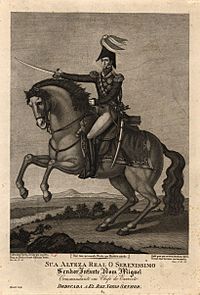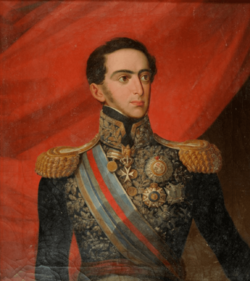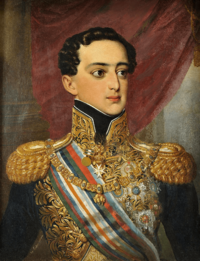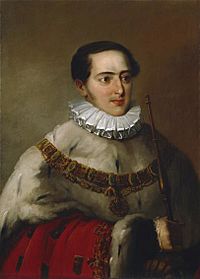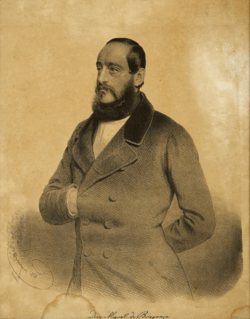Miguel I of Portugal facts for kids
Quick facts for kids Miguel I |
|||||
|---|---|---|---|---|---|
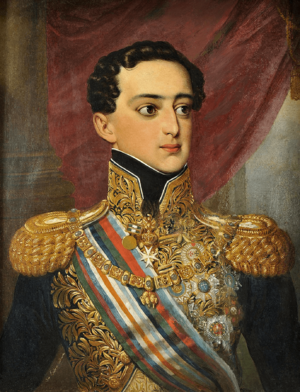
Portrait by Johann Ender, 1827
|
|||||
| King of Portugal | |||||
| Reign | 11 July 1828 – 26 May 1834 | ||||
| Acclamation | 11 July 1828 | ||||
| Predecessor | Maria II | ||||
| Successor | Maria II | ||||
| Born | 26 October 1802 Lisbon, Portugal |
||||
| Died | 14 November 1866 (aged 64) Esselbach, Württemberg |
||||
| Burial | Pantheon of the Braganzas, Lisbon, Portugal | ||||
| Spouse |
Princess Adelaide of Löwenstein
(m. 1851) |
||||
| Issue see details... |
|
||||
|
|||||
| House | Braganza | ||||
| Father | John VI of Portugal | ||||
| Mother | Carlota Joaquina of Spain | ||||
| Religion | Roman Catholicism | ||||
| Signature |  |
||||
Miguel I (born October 26, 1802 – died November 14, 1866) was the King of Portugal from 1828 to 1834. He was the seventh child and third son of King John VI and Carlota Joaquina of Spain. Miguel was known by nicknames like "the Absolutist" and "the Usurper."
After being sent away for supporting absolute rule, Miguel returned to Portugal. He came back as a regent (someone who rules for a young king or queen) and was supposed to marry his niece, Queen Maria II. However, Miguel claimed the throne for himself. He believed his older brother, Peter IV, and Peter's daughter, Maria, had lost their right to the throne. This was because Peter had become the ruler of another country (Brazilian Empire) and had fought against Portugal.
This led to a difficult time in Portugal, with many people being hurt or exiled. It eventually caused the Liberal Wars, a fight between those who wanted absolute rule and those who wanted a government with a constitution. Miguel was eventually forced to give up the throne. He spent the last 32 years of his life living outside Portugal.
Contents
Early Life of Miguel I
Miguel Maria do Patrocinio de Bragança e Bourbon was born in Queluz Royal Palace, Lisbon. His father, King John VI, made him the Duke of Beja. Miguel was the third son of King John VI and Queen Carlota Joaquina of Spain.
Miguel was his mother's favorite child. After her first son died, Miguel received most of her attention. His brother Peter was closer to their father.
In 1807, when Miguel was five, he traveled with the Portuguese Royal Family to Brazil. They went there to escape from the Napoleonic invasion of Portugal. He returned in 1821 with his parents. His brother Peter stayed in Brazil as regent.
Miguel was a lively child. He was known for riding around and playfully knocking off people's hats. He spent a lot of time with farm workers. People described him as someone who could be good when around good people, but worse than others when around bad people.
Revolts and Exile
Miguel strongly believed in absolute monarchy, where the king has all the power. He admired Prince Klemens Wenzel von Metternich, who thought that liberal revolutions (which give more power to the people) were not realistic.
When he was 20, Miguel first challenged the liberal government that was set up after the Liberal Revolution of 1820. In 1823, he led a counter-revolution called the Vilafrancada. He declared his support for an absolute monarchy. Miguel, supported by his mother, even asked the king to step down. However, the king managed to keep control. He abolished the 1822 Constitution and sent many liberals away. Miguel returned to Lisbon in triumph, but the king remained in charge.
After the Vilafrancada, Miguel became Commander-in-Chief of the Army. But his mother was unhappy that the king still supported liberals.
In 1824, Miguel ordered the arrest of ministers and other important people. He claimed there was a plot to kill the king. He placed his father under guard at Bemposta Palace. This event was called the Abrilada. Foreign diplomats realized the king was a prisoner. They helped the king escape onto a British warship. From the ship, the king removed Miguel from his army role and sent him away to Vienna. Miguel stayed there for over three years.
Return to Portugal
While in Vienna, Miguel was a guest of Klemens Wenzel, Prince von Metternich. In 1826, his father, King John VI, died. Miguel's brother Peter became King Peter IV. However, Peter wanted to remain Emperor of Brazil. So, after two months, he gave up the Portuguese crown to his young daughter, Maria II. Since Maria was too young to rule, Peter appointed his sister, Isabel Maria, as regent.
Peter tried to make peace with Miguel. He offered Miguel the role of regent of Portugal when Miguel turned 25. This would be under a new liberal plan called the Constitutional Charter. This plan would bring back a constitutional monarchy. Also, Queen Maria II and Miguel would marry when she was old enough. Miguel accepted this offer and promised to follow the Constitutional Charter.
The regency under Isabel Maria was very unstable. There were many disagreements in the government. Peter decided to give the kingdom to Miguel, who was eager to accept. Miguel left Vienna for Lisbon.
On his way back, he stopped in England in December 1827. He was welcomed by important members of the English court. The British government hoped to influence Miguel to accept the new constitutional plan. Miguel was well-received in London, attending events and meeting important people.
Becoming Regent
Miguel left England in January 1828 and arrived in Lisbon on February 22. His arrival was met with great excitement. Cannons fired, bells rang, and people cheered. Many people shouted, "Long live Lord D. Miguel, our Absolute King!" Some even shouted, "Death to D. Pedro!" and "Death to the liberal constitution!"
Miguel's role was clear: he was to rule as regent for Queen Maria II. When she was old enough, he would marry her and become her consort. He also had to rule according to Peter's Constitutional Charter, even though he preferred absolute monarchy.
On February 26, Miguel officially took on the role of regent. He was supposed to swear an oath to defend the Constitutional Charter. However, it was unclear if he actually said the words or kissed the Bible. Many people present felt that he was unwilling to take the oath.
Soon after, some citizens of Lisbon gathered to declare Miguel "Absolute King." This angered many liberal politicians. Within a week, Miguel and his mother began removing their old enemies and liberal supporters from the government and army.
King of Portugal
On March 13, 1828, Miguel closed the Cortes (the Portuguese parliament) without holding new elections, which the Constitutional Charter required. Many nobles, clergy, and citizens asked him to cancel the Charter and rule as king.
On May 3, 1828, nobles invited Miguel to call a new Cortes to decide who should legitimately rule. This Cortes met in June. On July 7, Miguel was declared the absolute ruler of Portugal.
Soon after, the military in Oporto revolted, supporting the liberal cause. But Miguel's forces were strong and surrounded the city. A similar revolt in Lagos was quickly stopped. Many liberals fled Portugal. All of Portugal recognized Miguel as king, except for the islands of Madeira and Terceira. Madeira was soon brought under control, but Terceira remained loyal to the liberal cause.
Miguel's supporters were very harsh towards liberals. Many people believed to be liberals were killed or punished. Even though some of Miguel's ministers disagreed with these actions, his mother continued to support them. These acts made Miguel's rule seem very cruel.
While Spain, the Holy See (the Pope's government), and the United States recognized Miguel as king, England and France did not support his rule. Miguel's government also bothered English and French citizens, which led to protests. Eventually, a French admiral sailed up the Tagus River and forced Portugal to sign a treaty in 1831. Still, the harsh treatment of liberals continued.
Liberal Wars and Abdication
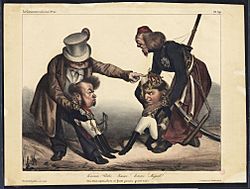
Only the island of Terceira in the Azores remained loyal to Queen Maria II. The liberal government continued to operate there in exile. The liberals eventually took control of all the Azores islands by 1831.
Peter, after giving up his title as Emperor of Brazil, took charge of the Liberal Army in 1831. From the Azores, he launched an invasion of northern Portugal, landing near Oporto, which he quickly took over. However, Miguel's army was strong and surrounded Oporto, laying siege to the city.
While Oporto was under siege, Lisbon fell to the liberals. The Duke of Terceira had sailed with the Liberal fleet, landed in the Algarve, and marched to Lisbon, taking the city on July 24.
Miguel was helped by French General Bourmont, who came to Portugal after the fall of King Charles X of France. Later, Scottish General Ranald MacDonnell took command of Miguel's army. He moved them to the strong position of Santarém, which became Miguel's base. The fighting continued fiercely.
However, politics sealed Miguel's fate. His alliance with Carlos of Spain angered Ferdinand VII of Spain, who then recognized Maria's claim to the Portuguese throne. Spain, France, and England formed an alliance with Maria and Peter.
A Spanish general entered Portugal, and the Duke of Terceira won the Battle of Asseiceira on May 16, 1834. This made Miguel's situation very difficult. Miguel escaped Santarém. His generals decided to stop fighting and ask for peace. Miguel accepted their decision.
After a three-year civil war, Miguel I was forced to give up his throne at the Concession of Evoramonte on May 26, 1834. Miguel left Portugal on June 1, 1834, and lived in exile in Italy, England, and Germany. He never returned to Portugal.
Life in Exile and Death
In December 1834, the Portuguese Cortes (parliament) banned Miguel and all his descendants from Portugal. This law remained in effect until 1950. During his exile, he was known by titles such as Duke of Braganza.
In 1837, the Spanish Cortes also removed Miguel from the Spanish line of succession. This was because he was in rebellion with his uncle Carlos, who also claimed the Spanish throne.
Miguel lived the rest of his life outside Portugal. Away from politics, his personality changed a lot. In his later years, he was a bearded older man, very different from his younger, wilder self. He refused to accept the terms of his abdication, which meant he lost his pension from the Portuguese government. For a while, he lived as a refugee in Rome, supported by the Pope.
In 1851, he moved to Germany and married Princess Adelaide of Löwenstein. They settled in a former monastery and had seven children. His wife helped arrange good marriages for all their daughters.
Miguel died while hunting in Germany on November 14, 1866. He was first buried in his wife's family vault. In 1967, his body and his wife's were moved to the Braganza pantheon in Lisbon.
Titles and Honours
| Royal styles of King Miguel I of Portugal |
|
|---|---|
 |
|
| Reference style | His Most Faithful Majesty |
| Spoken style | Your Most Faithful Majesty |
Miguel received many awards and honors during his life.
- Portuguese honours
- Grand Commander of the Three Military Orders of Christ, Aviz and St. James
- Grand Cross of the Tower and Sword
- Grand Cross of the Immaculate Conception of Vila Viçosa
- Grand Master of the Order of St. Michael of the Wing (later removed)
- Grand Prior of the Order of St. John of Jerusalem in Portugal
- Foreign dynastic orders
 Empire of Brazil: Grand Cross of the Southern Cross
Empire of Brazil: Grand Cross of the Southern Cross Spain:
Spain:
- Grand Cross of the Order of Charles III, February 19, 1802
- Knight of the Golden Fleece, February 19, 1804
 United Kingdom: Knight of the Thistle
United Kingdom: Knight of the Thistle Austrian Empire: Grand Cross of St. Stephen, 1826
Austrian Empire: Grand Cross of St. Stephen, 1826 Kingdom of France:
Kingdom of France:
- Knight of the Holy Spirit, 1823
- Knight of St. Michael, 1823
- Grand Cross of the Military Order of St. Louis
 Two Sicilies: Grand Cross of St. Ferdinand and Merit
Two Sicilies: Grand Cross of St. Ferdinand and Merit Russian Empire:
Russian Empire:
- Knight of St. Andrew, February 16, 1824
- Knight of St. Alexander Nevsky, February 16, 1824
- Knight of St. Anna, 1st Class, February 16, 1824
 Baden: Grand Cross of the House Order of Fidelity, 1827
Baden: Grand Cross of the House Order of Fidelity, 1827
Miguel was known by several nicknames:
- O Tradicionalista ("The Traditionalist")
- O Usurpador ("The Usurper")
- O Absolutista ("The Absolutist")
- O Sacrificado ("The Sacrificed")
- O Rei Absoluto ("The Absolute King")
Marriage and Descendants
In 1851, at age 48, Miguel married Princess Adelaide of Löwenstein. They had one son and six daughters.
| Name | Birth | Death | Notes |
|---|---|---|---|
| Infanta Maria das Neves | 5 August 1852 | 15 February 1941 | Married Alfonso Carlos, Duke of San Jaime, a claimant to the Spanish throne. |
| Infante Miguel | 19 September 1853 | 11 October 1927 | Became Duke of Braganza, and was the grandfather of the current claimant to the Portuguese throne, Duarte Pio, Duke of Braganza. |
| Infanta Maria Theresa | 24 August 1855 | 12 February 1944 | Became the third wife of Archduke Karl Ludwig of Austria. |
| Infanta Maria Josepha | 19 March 1857 | 11 March 1943 | Became the second wife of Karl Theodor, Duke in Bavaria. |
| Infanta Adelgundes | 10 November 1858 | 15 April 1946 | Became the second wife of Prince Enrico of Bourbon-Parma, Count of Bardi. |
| Infanta Marie Anne | 13 July 1861 | 31 July 1942 | Married Guillaume IV, Grand Duke of Luxembourg. |
| Infanta Maria Antónia | 28 November 1862 | 14 May 1959 | Became the second wife of Robert I, Duke of Parma. |
Ancestry
| Ancestors of Miguel I of Portugal | |||||||||||||||||||||||||||||||||||||||||||||||||||||||||||||||||||||||||||||||||||||||||||||||||||||||||||||||||||||||||||||||||||||||||||||||||||||||||||||||||||||||||||||||||||||||||||||||||||||||||||||||||||||||||||||||||||||||||||||||||||||||||||||||||||||||||||||||||||||||||
|---|---|---|---|---|---|---|---|---|---|---|---|---|---|---|---|---|---|---|---|---|---|---|---|---|---|---|---|---|---|---|---|---|---|---|---|---|---|---|---|---|---|---|---|---|---|---|---|---|---|---|---|---|---|---|---|---|---|---|---|---|---|---|---|---|---|---|---|---|---|---|---|---|---|---|---|---|---|---|---|---|---|---|---|---|---|---|---|---|---|---|---|---|---|---|---|---|---|---|---|---|---|---|---|---|---|---|---|---|---|---|---|---|---|---|---|---|---|---|---|---|---|---|---|---|---|---|---|---|---|---|---|---|---|---|---|---|---|---|---|---|---|---|---|---|---|---|---|---|---|---|---|---|---|---|---|---|---|---|---|---|---|---|---|---|---|---|---|---|---|---|---|---|---|---|---|---|---|---|---|---|---|---|---|---|---|---|---|---|---|---|---|---|---|---|---|---|---|---|---|---|---|---|---|---|---|---|---|---|---|---|---|---|---|---|---|---|---|---|---|---|---|---|---|---|---|---|---|---|---|---|---|---|---|---|---|---|---|---|---|---|---|---|---|---|---|---|---|---|---|---|---|---|---|---|---|---|---|---|---|---|---|---|---|---|---|---|---|---|---|---|---|---|---|---|---|---|---|---|---|---|---|
|
|||||||||||||||||||||||||||||||||||||||||||||||||||||||||||||||||||||||||||||||||||||||||||||||||||||||||||||||||||||||||||||||||||||||||||||||||||||||||||||||||||||||||||||||||||||||||||||||||||||||||||||||||||||||||||||||||||||||||||||||||||||||||||||||||||||||||||||||||||||||||
See also
 In Spanish: Miguel I de Portugal para niños
In Spanish: Miguel I de Portugal para niños


